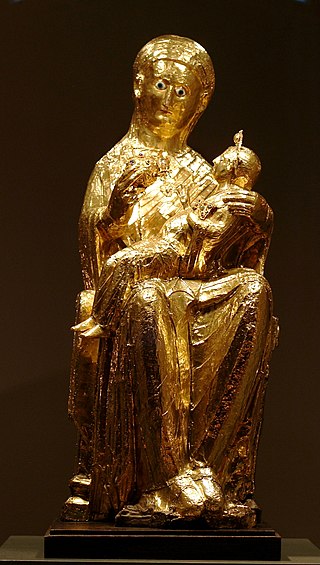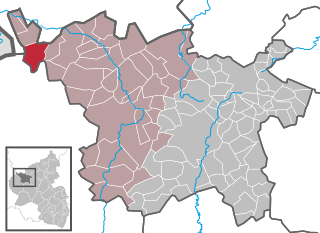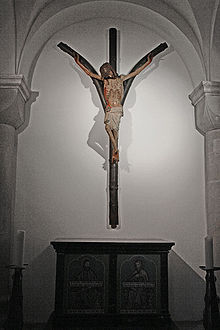
Cologne Cathedral is a cathedral in Cologne, North Rhine-Westphalia belonging to the Catholic Church. It is the seat of the Archbishop of Cologne and of the administration of the Archdiocese of Cologne. It is a renowned monument of German Catholicism and Gothic architecture and was declared a World Heritage Site in 1996. It is Germany's most visited landmark, attracting an average of 6 million people a year. At 157 m (515 ft), the cathedral is the tallest twin-spired church in the world, the second tallest church in Europe after Ulm Minster, and the third tallest church of any kind in the world.

Anne Catherine Emmerich was a Catholic Augustinian canoness of the Congregation of Windesheim. During her lifetime, she was a purported mystic, Marian visionary, ecstatic and stigmatist.

A rood or rood cross, sometimes known as a triumphal cross, is a cross or crucifix, especially the large crucifix set above the entrance to the chancel of a medieval church. Alternatively, it is a large sculpture or painting of the crucifixion of Jesus.

The Gero Cross or Gero Crucifix, of around 965–970, is the oldest large sculpture of the crucified Christ north of the Alps, and has always been displayed in Cologne Cathedral in Germany. It was commissioned by Gero, Archbishop of Cologne, who died in 976, thus providing a terminus ante quem for the work. It is carved in oak, and painted and partially gilded – both have been renewed. The halo and cross-pieces are original, but the Baroque surround was added in 1683. The figure is 187 cm high, and the span of its arms is 165 cm. It is the earliest known Western depiction of Christ on the cross while dead; earlier depictions had Christ appearing alive.

The Golden Madonna of Essen is a sculpture of the Virgin Mary and the infant Jesus. It is a wooden core covered with sheets of thin gold leaf. The piece is part of the treasury of Essen Cathedral, formerly the church of Essen Abbey, in North Rhine-Westphalia, Germany, and is kept on display at the cathedral.

Ormont is an Ortsgemeinde situated in the Vulkaneifel district in Rhineland-Palatinate, Germany. It belongs to the Verbandsgemeinde of Gerolstein, whose seat is in the municipality of Gerolstein.

Conrad von Soest, also Konrad in modern texts, or in Middle High German Conrad van Sost or "von Soyst", was the most significant Westphalian artist and painted in the so-called soft style of International Gothic. He played a leading role in the introduction of this International Courtly Style to Northern Germany around 1390 and influenced German and Northern European painting into the late 15th century. He was the master of a thriving workshop and was accepted into the social circle of the cosmopolitan patrician elite of Dortmund. Dortmund was then a leading and very prosperous member of the influential Hanseatic League.

Crucifixions and crucifixes have appeared in the arts and popular culture from before the era of the pagan Roman Empire. The crucifixion of Jesus has been depicted in a wide range of religious art since the 4th century CE, frequently including the appearance of mournful onlookers such as the Virgin Mary, Pontius Pilate, and angels, as well as antisemitic depictions portraying Jews as responsible for Christ's death. In more modern times, crucifixion has appeared in film and television as well as in fine art, and depictions of other historical crucifixions have appeared as well as the crucifixion of Christ. Modern art and culture have also seen the rise of images of crucifixion being used to make statements unconnected with Christian iconography, or even just used for shock value.

Münster Cathedral or St.-Paulus-Dom is the cathedral church of the Catholic Diocese of Münster in Germany, and is dedicated to Saint Paul. It is counted among the most significant church buildings in Münster and, along with the City Hall, is one of the symbols of the city.

St. Maria im Kapitol is an 11th-century Romanesque church located in the Kapitol-Viertel in the old town of Cologne, Germany. The name “im Kapitol“ refers to the Roman temple for the Capitoline Triad that was built on today’s site of the church in the first century. The Catholic church is based on the Church of the Nativity in Bethlehem, was dedicated to St. Mary and built between 1040 and 1065. It is one of twelve Romanesque churches built in Cologne during this period.

Wesel is a railway station in Wesel, North Rhine-Westphalia, Germany. The station is located on the Arnhem-Oberhausen railway and the Bocholt-Wesel railway. The train services are operated by Deutsche Bahn and Abellio Deutschland.

The Aachen Altar or Passion Altar (Passionsaltar) is a late gothic passion triptych in the Aachen Cathedral Treasury, made by the so-called Master of the Aachen Altar around 1515/20 in Cologne.

The Cross of Otto and Mathilde, Otto-Mathilda Cross, or First Cross of Mathilde is a medieval crux gemmata processional cross in the Essen Cathedral Treasury. It was created in the late tenth century and was used on high holidays until recently. It is named after the two persons who appear on the enamel plaque below Christ: Otto I, Duke of Swabia and Bavaria and his sister, Mathilde, the abbess of the Essen Abbey. They were grandchildren of the emperor Otto I and favourites of their uncle, Otto II. The cross is one of the items which demonstrate the very close relationship between the Liudolfing royal house and Essen Abbey. Mathilde became Abbess of Essen in 973 and her brother died in 982, so the cross is assumed to have been made between those dates, or a year or two later if it had a memorial function for Otto. Like other objects in Essen made under the patronage of Mathilde, the location of the goldsmith's workshop is uncertain, but as well as Essen itself, Cologne has often been suggested, and the enamel plaque may have been made separately in Trier.

The Coesfeld Cross is a forked crucifix located in the Church of Saint Lambert in Coesfeld.

The Bocholt Cross is a forked crucifix in St. George's Church in Bocholt, in the German state of North Rhine-Westphalia and dates to the early 14th century. It is the oldest and most significant ornament of this church and the focal point of a regional pilgrimage today.

Branchwork or branch tracery is a type of architectural ornament often used in late Gothic architecture and the Northern Renaissance, consisting of knobbly, intertwined and leafless branches. Branchwork was particularly widespread in Central European art between 1480 and 1520 and can be found in all media. The intellectual origin of branchwork lies in theories in Renaissance humanism about the origins of architecture in natural forms and barely-treated natural materials.

Ida was abbess of the convent St. Maria im Kapitol in Cologne. She belonged to the family of the Ezzonids, who became prominent in Lower Lorraine in the 11th century.

The Přemyslid Crucifix is a polychromed wooden cross from Jihlava dating from the first half of the 14th century. It is on display at the Picture Gallery of Strahov Monastery in Prague. In 2010, it was declared a national cultural monument by the Czech government.

The Pietà from the Dominican Monastery in Cheb is a Gothic wooden pieta sculpture set in Cheb, Czech Republic.
Elmar Hillebrand was a German sculptor.
























